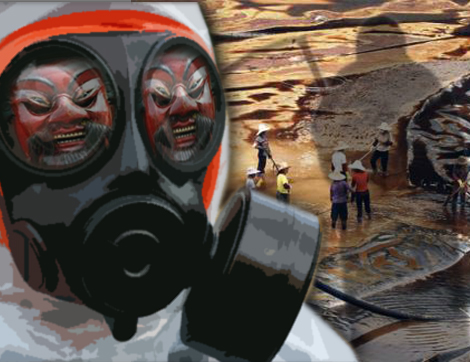
By Victor Thorn
Over the weekend of September 7, residents of Chongqing, China, woke to find the Yangtze River, the 3rd-longest river in the world, running a startling reddish-orange color. In any other part of the world, people would find such a sight alarming. Yet in China’s largest commercial centers, environmental pollution has become business as usual.
Of late, the Chinese government has been trying to blame these catastrophes on natural disasters, but in actuality the majority are man-made—the result of unlimited urban sprawl and industrialization.
With 75% of China’s energy still produced with coal, a yellowish haze blanketing the air frequently causes residents to remain indoors. In a September 6, 2011 article, journalist Gervase Poulden claimed that 16 of the world’s 20 most polluted cities are now found in China.
The future looks even less promising. According to Poulden, two decades ago, a mere 37K automobiles traversed China’s highways. Today, that number has leaped to 35 million, with predictions pushing it to 150 million by 2020.
If smog doesn’t sicken people, toxic chemicals will. Rivers and land are saturated with arsenic and heavy metals. Barrels of industrial waste are routinely dumped over the ground and into waterways by a quarter-million different mining companies. Some 40% of the country’s drinking water is unfit for consumption.
To cover up these atrocities, corporations increasingly bribe journalists and government officials to turn a blind eye.
Humans aren’t the only ones suffering. Fish turn up dead in streams, while other forest life has been forced to flee from toxic habitats. Once-prized species such as giant pandas, exotic birds, Asian elephants, Siberian tigers and Chinese alligators have become so rare in today’s China that one-quarter of all endangered animals now live in the country. Rampant hunting and the incredible growth of rubber tree plantations are among the reasons cited for wiping out these rare creatures.
Out-of-control logging outfits and an expansion of farming to feed 1.3 billion citizens have created situations that are literally threatening life in China: deforestation and desertification. Rampant use of fertilizers, eroded topsoil that isn’t replenished and tens of millions of overgrazing livestock have depleted land around the country. A confluence of these is now creating what are known as mega-deserts that are quickly growing across China. Nearly 30% of China is currently plagued by desertification, and it’s estimated that 4,000 villages have been gobbled up by these deserts, leaving tens of thousands of refugees in their wake.
Recently it has gotten so bad that dust from giant sandstorms in China travels to the U.S. West Coast and Canada.
And what is China doing to combat these arid conditions? Chinese officials have resorted to a topic covered by AMERICAN FREE PRESS over the last couple of years: weather modification through cloud seeding. AFP has pointed out in several articles that cloud seeding is an inexact science that can lead to various disasters including drought, wildfires and flooding.
Victor Thorn is a hard-hitting researcher, journalist and author of over 50 books.

